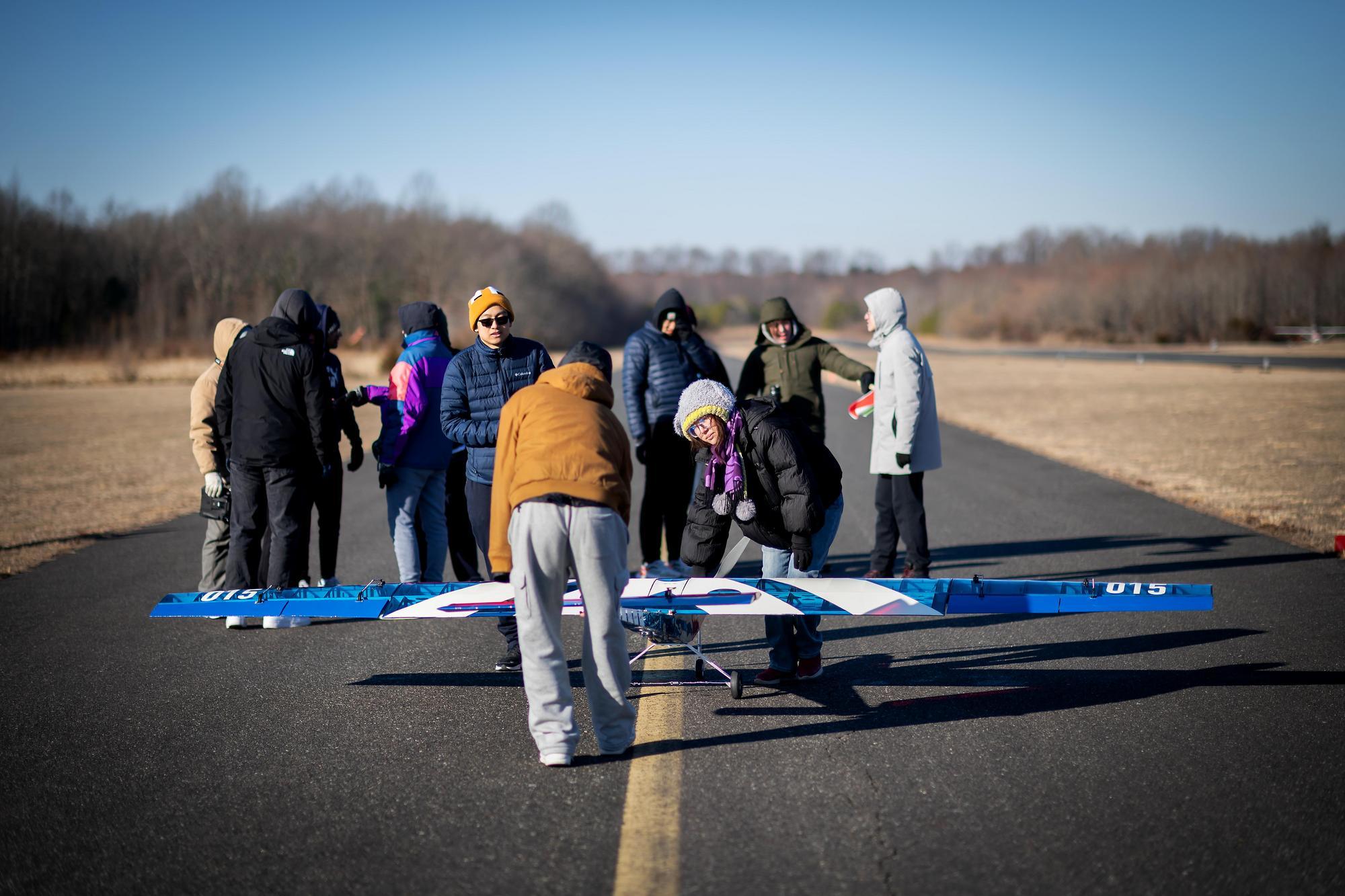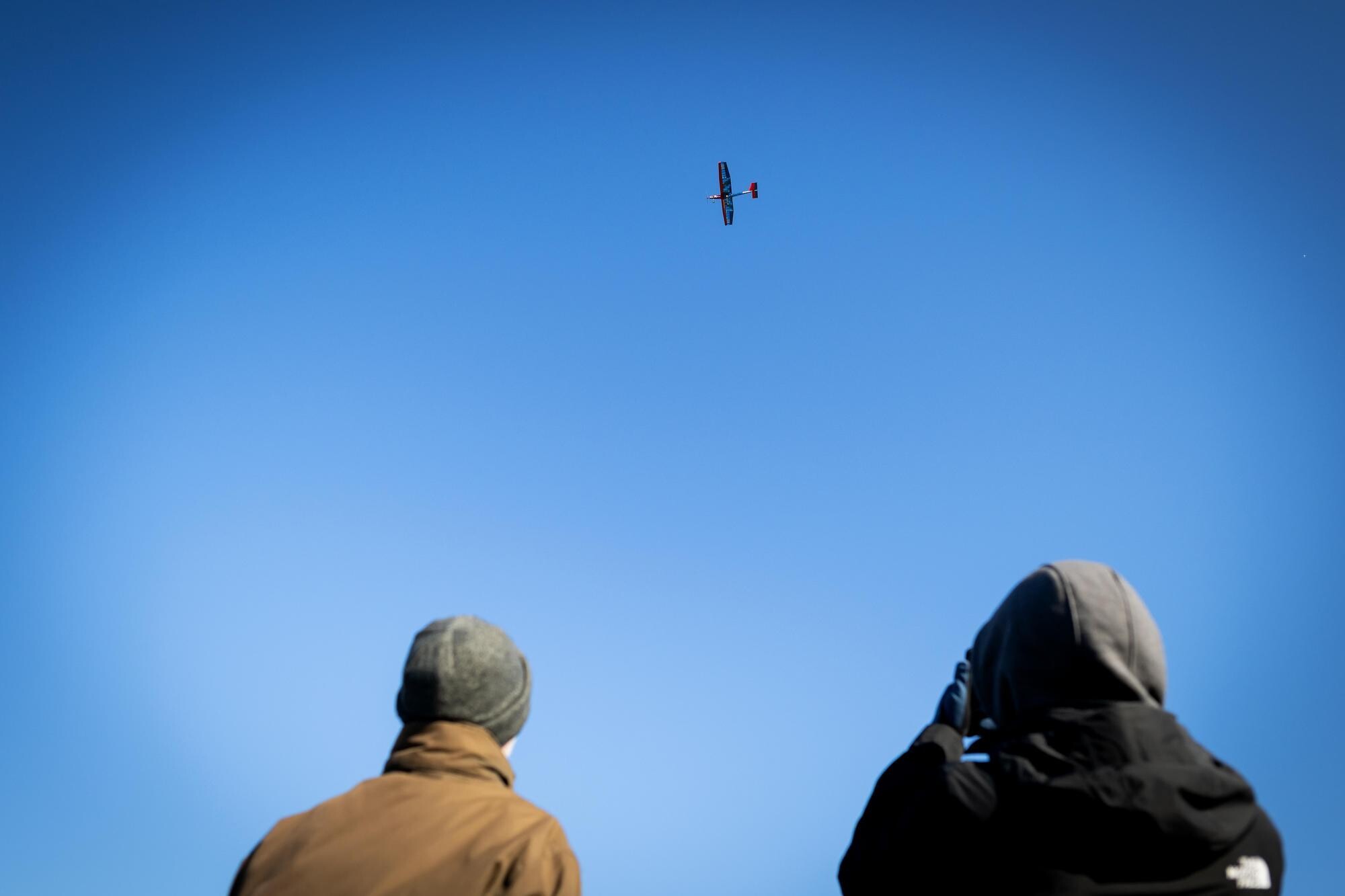
(From left) Doctoral student Hannah Yamagata, research assistant professor Kushol Gupta, and postdoctoral fellow Marshall Padilla holding 3D-printed models of nanoparticles.
(Image: Bella Ciervo)

7 min. read
On a pre-dawn morning in mid-February, two dozen students from Penn huddled together on a New Jersey airfield, anxiously awaiting a pivotal test flight. Breath visible in the chilled air, their nerves and excitement merged as their largest-ever model airplane began its takeoff roll, gracefully lifting off and soaring into the winter sky.
“It was pretty cold, but we had so many other things on our minds that day,” says Xiangyu Chen, a fourth-year student in the School of Engineering and Applied Science from Grand Rapids, Michigan.
For more than 10 years, Penn Aerial Robotics (Penn AiR), a student-run club, has been carefully crafting electric aircraft, improving their performance and maneuverability.
Now, Chen, the club’s president, and his team wait to see if their flying machines can pass muster at the SAE Aero Design 2025 in Los Angeles, running from April 4 to 6.
At this stage, there’s still plenty to finalize. “We’re kind of just racing against time, right?” Chen chuckles. “But overall, everyone’s very excited. We’re anticipating doing pretty well—we’re just a little stressed because of all the logistics.”
One daunting task is ensuring the larger of their two aircraft (Equinox) reaches Los Angeles safely. “Figuring out how to transport Equinox without damage keeps me up at night,” Chen says.
“I’d say we’re a little frantic, a little stressed at the moment,” adds Avaniko Asokkumar, a third-year Penn Engineering student from Dallas, Texas, who serves as vice president of finance. Beyond his official title, Asokkumar, like Chen and others, plays multiple roles across operations and software sub teams, particularly focusing on Eclipse, the smaller and more technically ambitious aircraft.
Each Penn AiR aircraft is built for a different class of the competition.
In Regular Class, they’ll fly Equinox, a massive radio-controlled plane designed to haul heavy payloads (cargo weight). As Penn AiR’s heavy lifter, Equinox wields a 15-foot wingspan—about the size of a small glider—and a maximum takeoff weight of 50 pounds.
Nearly two-thirds of that weight can be payload, as Equinox is capable of carrying up to 31 pounds of cargo in flight. (In competition, “payload” might be anything from steel plates to bags of sand—the goal is to lift as much weight as possible.) With a wingspan at the competition’s limit and a broad wing airfoil designed for lift, Equinox looks every bit a cargo plane in miniature. It needs about a 100-foot runway to get airborne, and cruises at around 23.5 mph in the air—a leisurely pace befitting its job as a hauler.
Lightweight balsa wood is used for the wings and fuselage, Asokkumar notes. “It’s our main structural material, and it’s surprisingly really expensive,” he says. “The wood is laser-cut and glued into ribs, spars, and stringers.”
In Advanced Class, they’re entering Eclipse, a cutting-edge autonomous vertical takeoff or landing (VTOL) aircraft. In stark contrast to its larger sibling, Eclipse’s wing spans just 30 inches across, and at about 2.7 pounds unloaded, it’s light enough for one person to carry in one hand.
But don’t be fooled by its diminutive stature—Eclipse is arguably the more technologically ambitious of the pair. As a VTOL aircraft, it can take off and land vertically like a helicopter or drone instead of needing a runway, essentially functioning as a plane and multirotor drone in one platform.
Two electric motors mounted on its carbon-fiber wings can tilt upward for hover mode, then pivot forward once the plane is in the air. This design allows Eclipse to launch forward like a normal plane, then mid-flight, transition into a hovering mode.
“Why would one do that?” asks Ethan Yu, a third-year student in Penn Engineering from Campbell, California, who serves as Eclipse’s software team co-leader. “Because the SAE Advanced Class challenge this year actually flips the usual VTOL script.”
Usually, if takeoff space is constrained, pilots want to take off vertically and then fly horizontally, Yu explains, but the competition rules mandate a horizontal takeoff.
By doing this, the tricky part comes later as Eclipse will have to switch from winged flight to hovering in order to fulfill a mission task: capturing a target payload on a small runway-less platform. Later, it must transition back and land.
Pulling off this hover–to–flight dance is no easy task. “Vertical to horizontal is pretty easy, but horizontal to vertical is a lot harder,” Yu points out. To transition from forward flight to a hover, the aircraft must carefully bleed off its forward momentum and rely on its props to keep it aloft. “You have to redirect all the forward momentum and slowly tilt the rotor so that you replace it with lift,” he explains.
As the plane slows down, its propellers gradually swing from pushing it forward to holding it up, preventing an aerodynamic stall. It’s a delicate maneuver that most real-world aircraft avoid—after all, commercial drones start vertically and then go horizontal, not the other way around. But this unusual requirement is “just what we settled on for the competition,” Yu says, and the Penn team has embraced this challenge.
They’ve run extensive computer simulations to practice the transition, using a custom-built virtual testbed to model each motor and control surface.
The software has coded autonomous vision algorithms—demonstrating the “robotics, computer vision, and machine learning” mix that drew Yu to Penn AiR in the first place.
Chen notes that Penn AiR’s journey to this point has been anything but simple. “When I came in Fall of 2021, we had about 15 active members,” says Chen. “When in-person activities shut down, continuity was lost—graduating seniors took their hard-earned know-how with them.”
The team didn’t have many third- or fourth-year students to reach out to, adds Sakshi Lende, a fourth year from Wayne, New Jersey, who oversees Penn AiR’s operations as the vice president.
As a result, when students like Lende joined the following year, they found themselves piecing together the basics almost from scratch. “Post-COVID, it was definitely really difficult figuring out how to make everything work,” she says.
However, the team got to work rebuilding not just airplanes but institutional memory. They began meticulously documenting designs, coding practices, and lessons learned so future members wouldn’t be left in the dark, Lende notes, adding that “now new recruits have a trove of information to draw on, they can learn from our past successes and mistakes.”
Just as importantly, the club fostered a strong mentorship culture. Experienced students make a point of guiding newcomers. Lende and Yu credit Chen for his hard work in helping onboard newer members. He “definitely went above and beyond, to make sure everyone had a task to do” and knew where to find information if they needed it, says Lende. As a result, younger members can “join the team and immediately get into the swing of things instead of having a long transition period,” she adds.
That supportive, learning-first environment has paid off. Penn AiR has grown from a handful of veterans to a robust, multi-disciplinary team. Lende herself experienced the “club’s welcoming vibe” when she first encountered them at the Student activities Fair in her second year. “It immediately stood out to me as a very welcoming environment,” she says.
Yu, similarly, was drawn in by the club’s inclusive spirit and the unique blend of skills it required. “There are obviously many clubs at Penn to choose from,” he says, but Penn AiR was the only one that combined robotics, computer vision, and machine learning in a “hands-on, industrial-level project.” Plus, he adds with a grin, “planes are just really cool.”
Chen echoes a similar sentiment and motivation for joining and subsequently reviving Penn AiR, as he says he has always been interested in aerospace and has built model airplanes since high school. “I’m a very hands-on kind of person. I want to build things outside of classes.”
Asokkumar and Lende were motivated to join based on a shared long-standing interest in robotics and desire as engineering students to be involved in something interdisciplinary, working with both software and hardware teams.
As the competition draws close, the Penn AiR workshop is a flurry of activity. In a crowded campus lab and a nearby machine shop, team members are putting in extra hours to iron out last-minute kinks.
There’s an endless stream of parts to tweak, code to refine, and checklists to run through. The energy is a mix of nervous tension and determined excitement. “At the moment, there’s a lot of work to be done,” Yu notes, conscious of how little time remains.
Yet, the team’s morale is high. They’ve seen their planes fly in tests, and that taste of success fuels confidence. Lende is eager to see all the toil pay off in the spotlight of competition. “I’m pretty excited to go to the competition, since this is my last year to have that opportunity,” she says. “I just really want to see the planes fly.”
For her, watching Equinox and Eclipse soar in front of judges and peers will be a victory in itself. “I think the teams have been working really hard, and I’m excited to see the output of that,” Lende adds.
Chen note the Penn AiR team is grateful to those who’ve made their journey possible: “We absolutely couldn't have done it without the Valley Forge Signal Seekers RC Club.”
The local remote-controlled aircraft enthusiasts provided invaluable mentorship, guidance, and piloting expertise, helping the Penn students transform their ideas into reality.
Yu is also thankul for the effort of Sid Deliwala, the club’s faculty advisor. “Sid’s support has been absolutely critical,” he says, noting how Deliwala consistently advocated for the club, facilitated access to lab spaces, and provided crucial advice throughout the process. “He’s been gracious and instrumental in navigating logistics, helping ensure we had the resources we needed,” adds Lende.
Lende highlights the outreach conducted by the club’s operations team, which fostered sponsorships and alumni engagement that boosted the club’s growth. “Our operations team handled everything from event planning to sponsorship coordination,” she explains. “They made it possible for us to focus on the engineering.”


(From left) Doctoral student Hannah Yamagata, research assistant professor Kushol Gupta, and postdoctoral fellow Marshall Padilla holding 3D-printed models of nanoparticles.
(Image: Bella Ciervo)

Jin Liu, Penn’s newest economics faculty member, specializes in international trade.
nocred

nocred

nocred